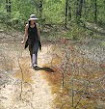
If you even think you're interested, buy it.
To find out more please see the book's website.
I've just finished collecting some of the later seeds from my Shrubby St. John's-wort (I agree with the book: these are "lovely shrubs ...deserving more use in sunny yards, including edge of pools and stream gardens"), and with them I marked the end of my first year with this book. It has taken me that long to read it simply because it takes at least all four seasons to observe what it has to teach, not just about seed collection & propagation, but professional and personal lifetimes' worth of growing, conserving, observing and educating people about our native trees and many of our shrubs too. Most of it was new to me.
The first few chapters are treasures of practical and experienced seed collecting, propagation and even restoration advice. Next, specific advice about collecting and propagating by family and species. All the while, the handy reference charts at the back of the book show you month-by-month which species' mature seeds you can expect to find and their stratification protocols.
I began to read what I could already use and understand late last fall. For the 1st time in my life, I realized that the phrase "instant classic" could even be trusted. By summer it wasn't a book or a manual or even a guide so much as a wise, warm and gentle field companion. Like walking land with an extra set of the finest tuned eyes. I love how intuitively organized and accessible this book's format is, and its unmistakable voice too: like the best teachers, it doesn't care about what it 'knows' as much as presenting information and guidance in ways that will enable the reader to learn. And it knows what you want (and need) to learn, even before you do :) After awhile I had to laugh each time it inevitably anticipated and answered my questions while I was still fumbling to formulate them!
I was especially grateful each time it anticipated any confusion I would have about similar and introduced species and hybrids. Not that it's a beginner tree ID guide (I still needed those. If you do too: see native plant ID links in the right side bar. Also, after basic ID guides, Gerry Waldron's Trees of the Carolinian Forest: A Guide to Species, Their Ecology and Uses is an especially apt companion to this book), but it is uniquely helpful for fine scale ID.
To the family and friends of the late Henry Kock, co-authors and editors Paul Aird, John Ambrose and Gerald Waldron and all the good people who helped complete, fund, support and steward this important book into being: I hope you will always know you have given us all a gift that can't be measured. *thank you*.
23 December 2009
Henry Kock's "Growing Trees from Seed - A practical guide to growing native trees, vines and shrubs"
Subscribe to:
Post Comments (Atom)

2 comments:
Sounds like a wonderful resource. I heard Henry Kock speak once, and still have my notes. Thanks for the review.
Henry was my neighbour for many years and taught me how to grow trees. He would have loved this review of the book. Originally he wanted to call the book, Seed Rain, for he believed that the real essence of green forests was the rain of seeds that starts it all and feeds so many creatures. Your enthusiasm for his book would have brought a great smile buried in his long beard and would have demanded a large hug for such an honest & enthusiastic approach to his structure and the labour that is now his life's work.Your comments demonstrate his goals were achieved. More than an exceptional manual, there are many momments where Henry's voice & warm personality comes through and reminds me of how much he sincerely cared for this planet. I still think the culmination of his efforts was to inspire people to be better people. And you know what, better people tend to grow forests. St. John's Wort was Henry's favourite shrub. I had the honour of planting one out in his forest after he passed on. What remarkably odd spherical flowers, so intriguing, so inviting. Happy planting.
Post a Comment